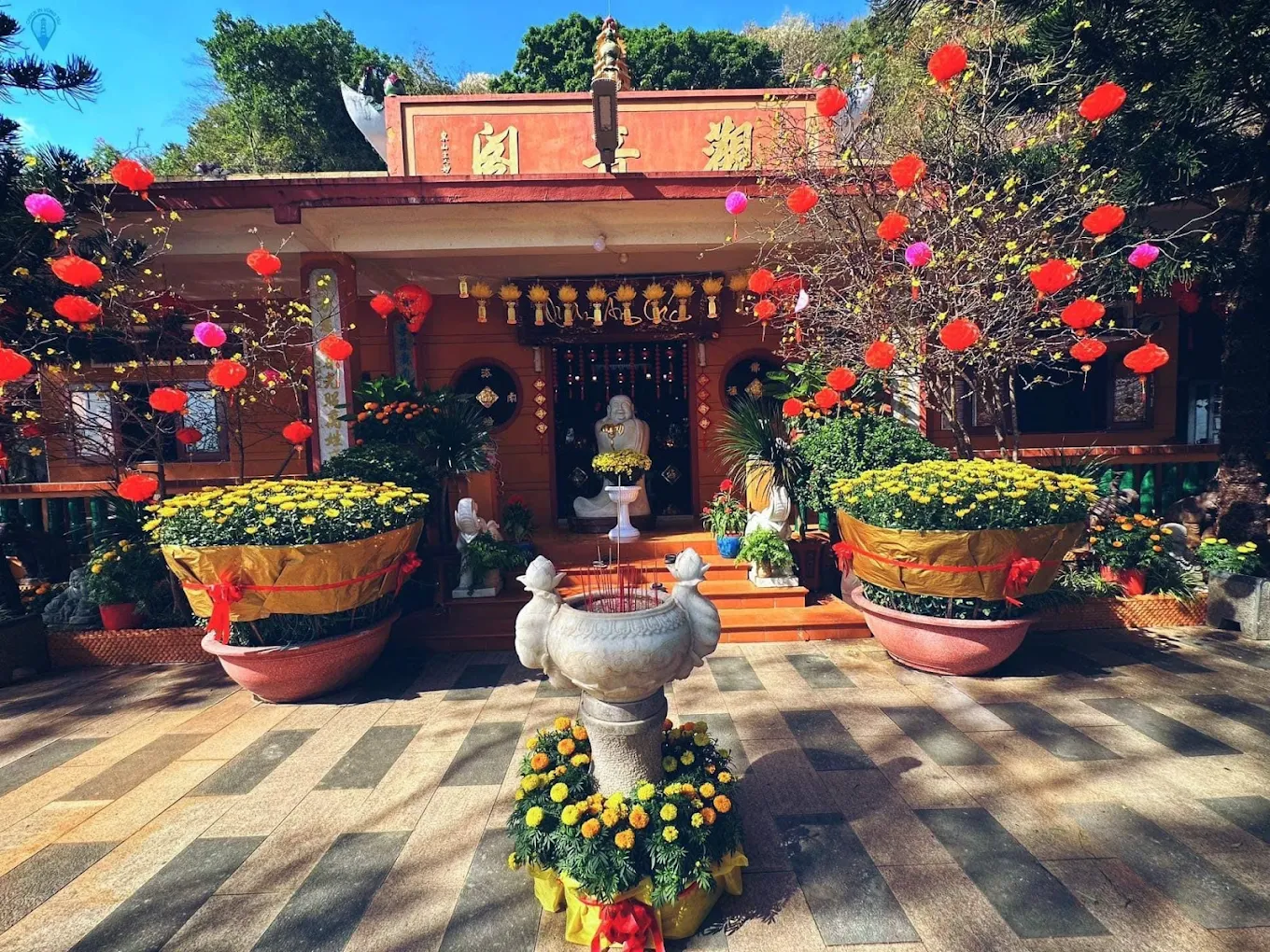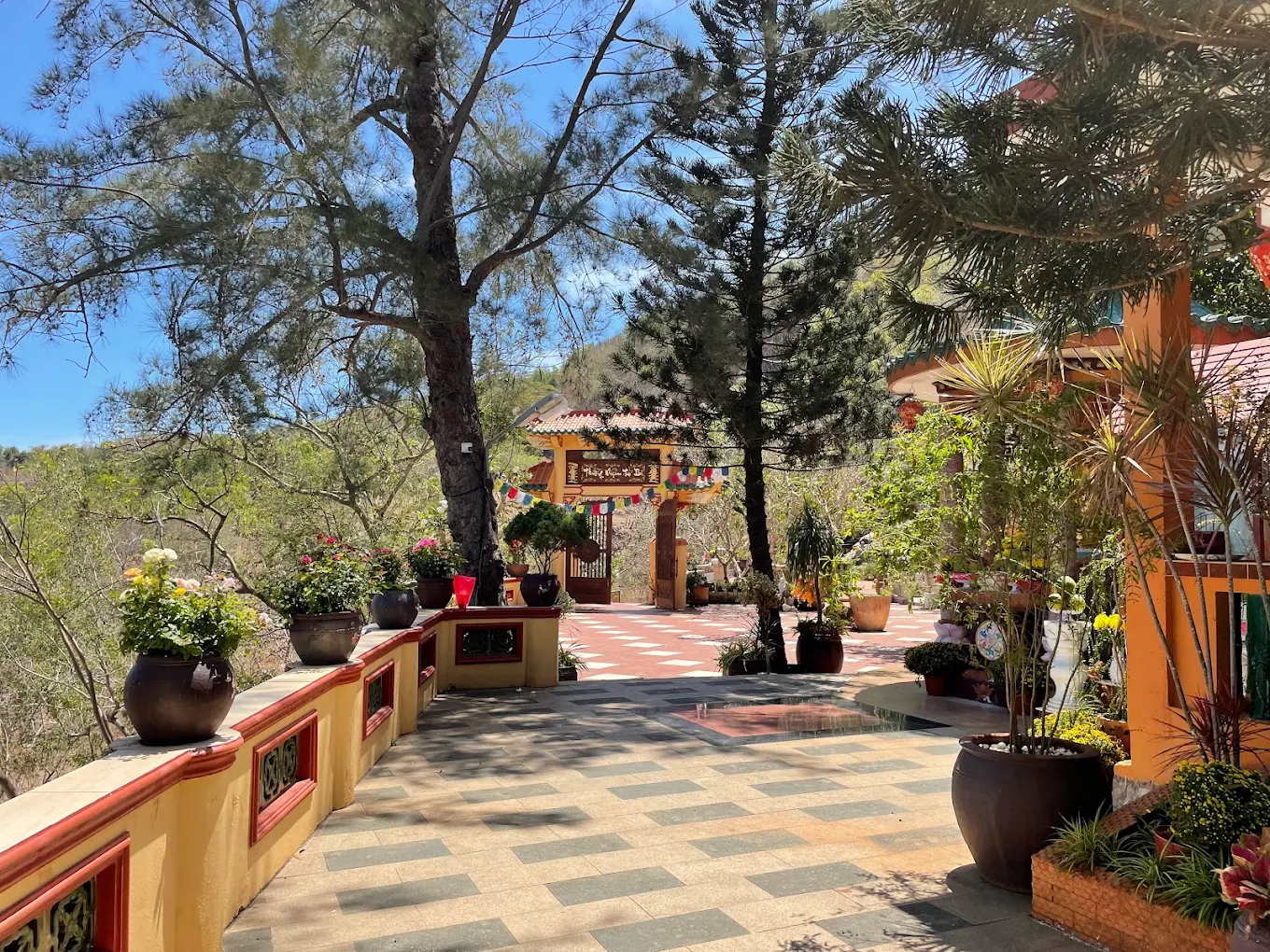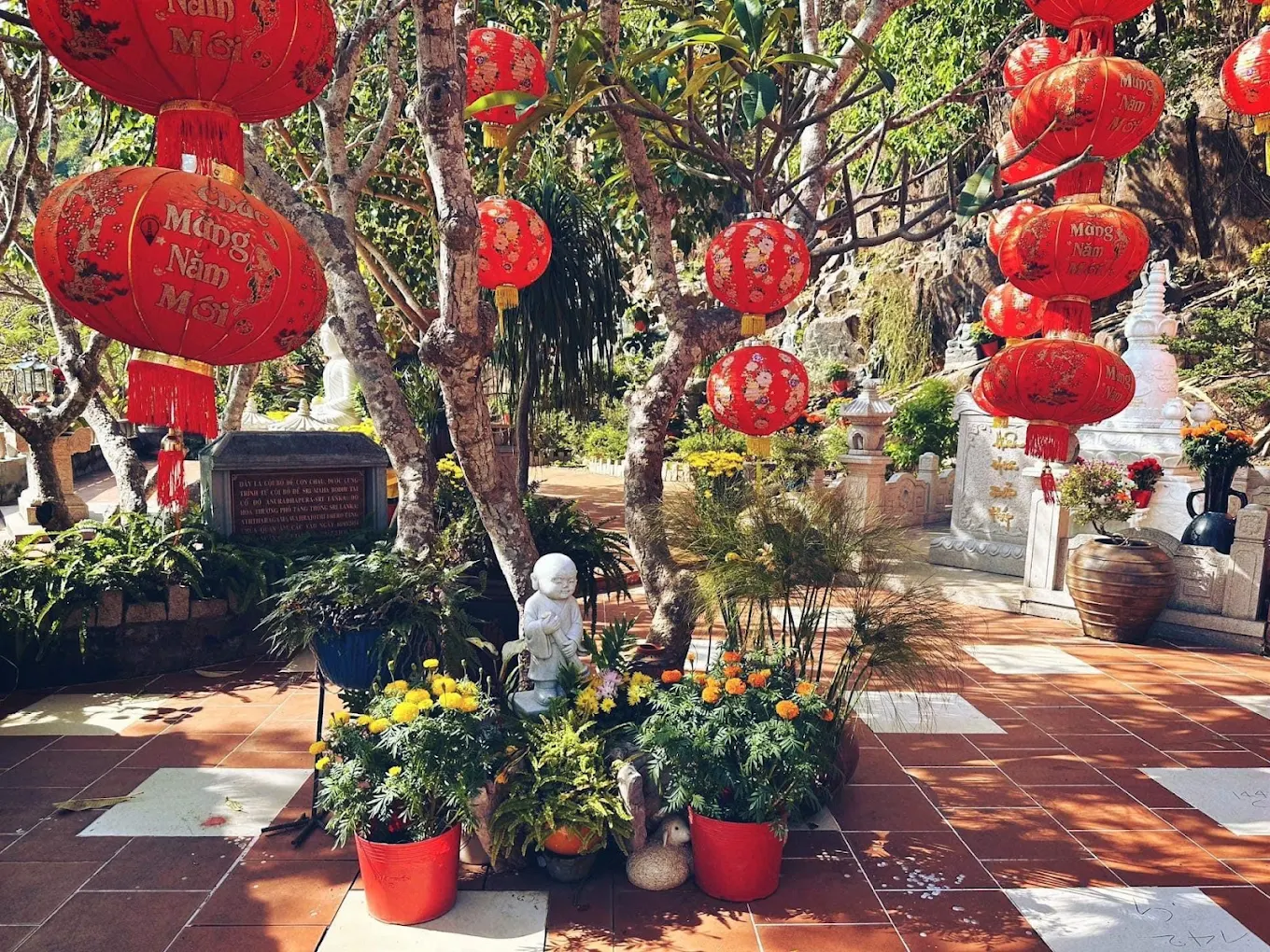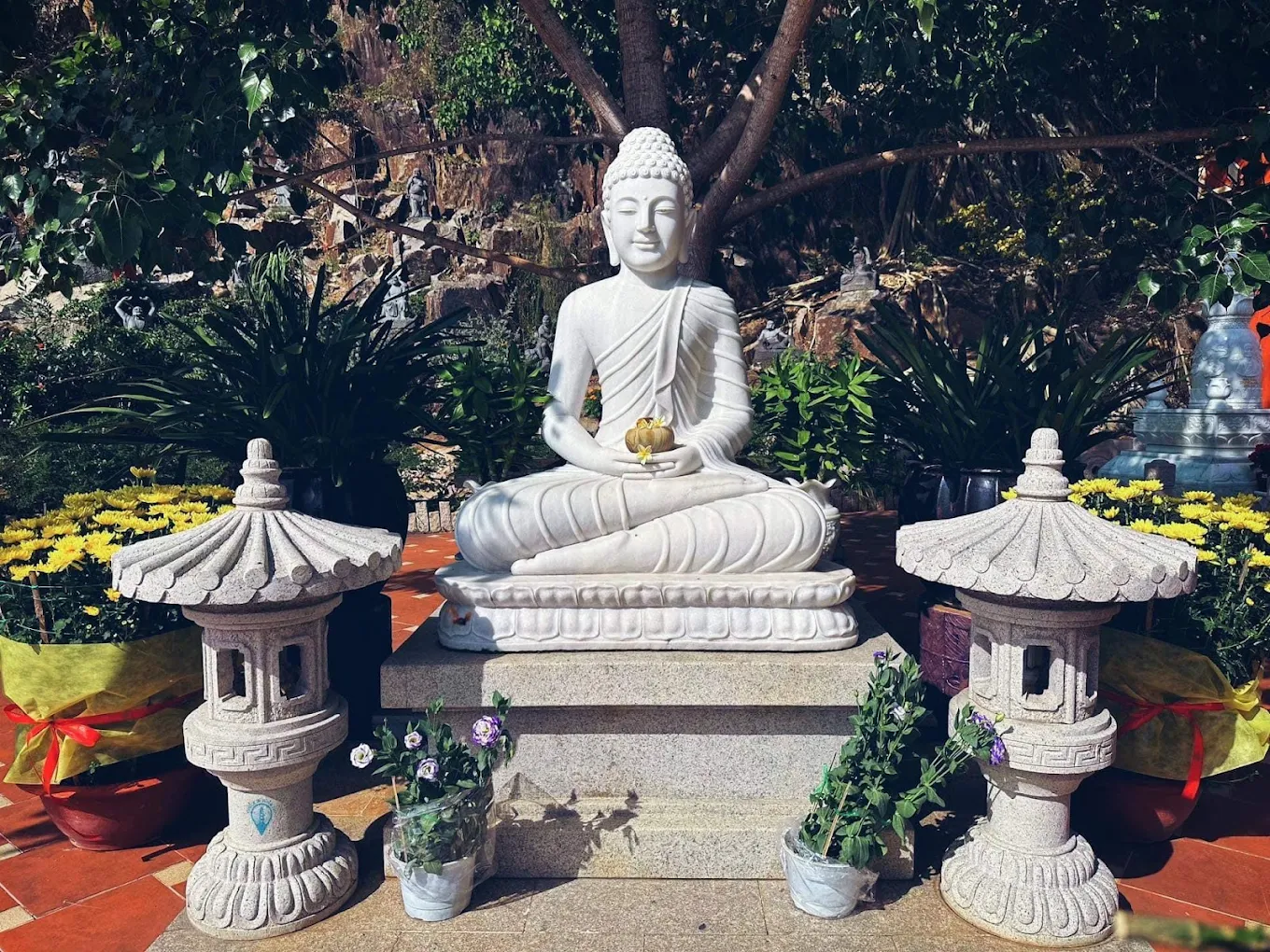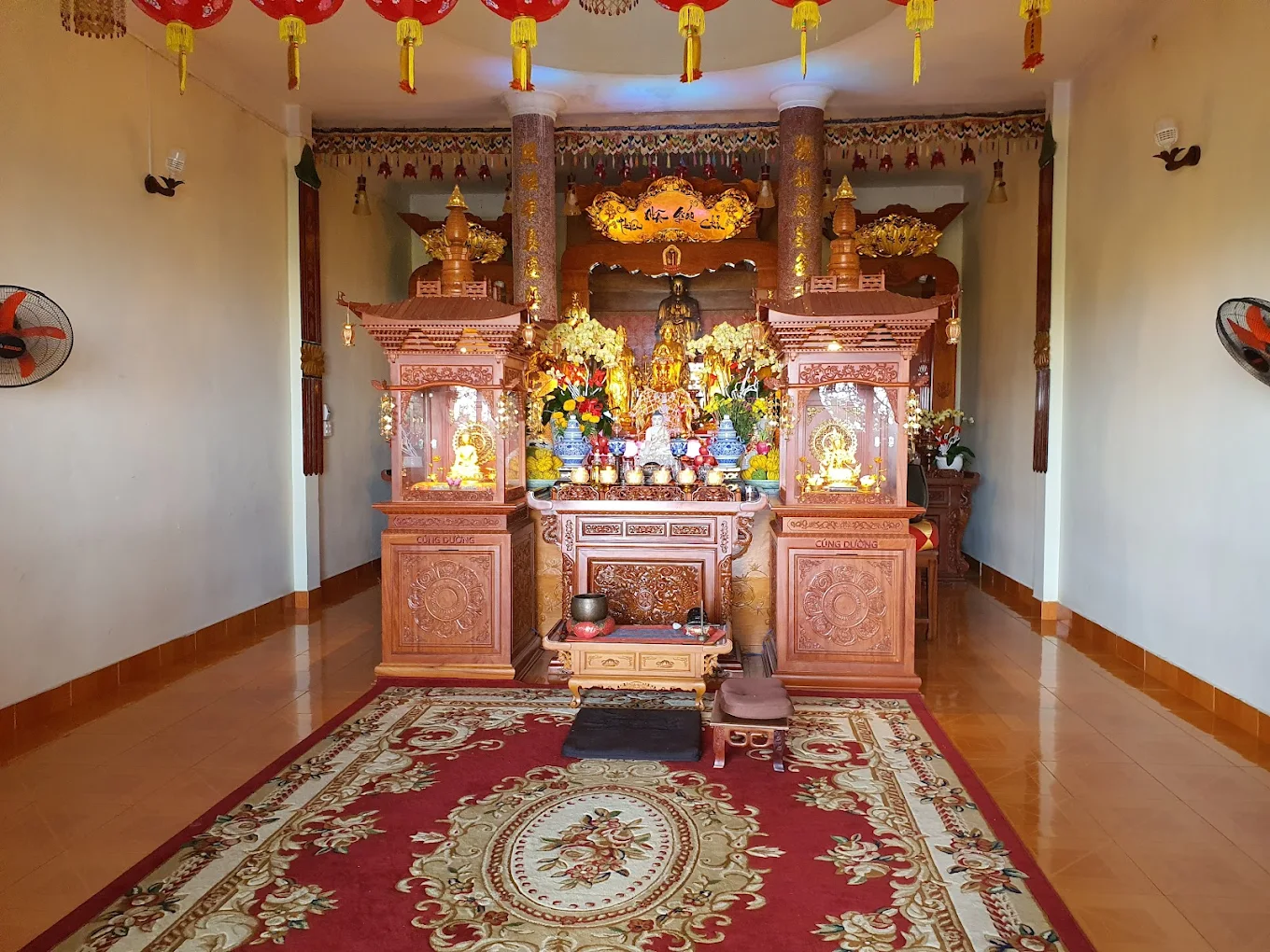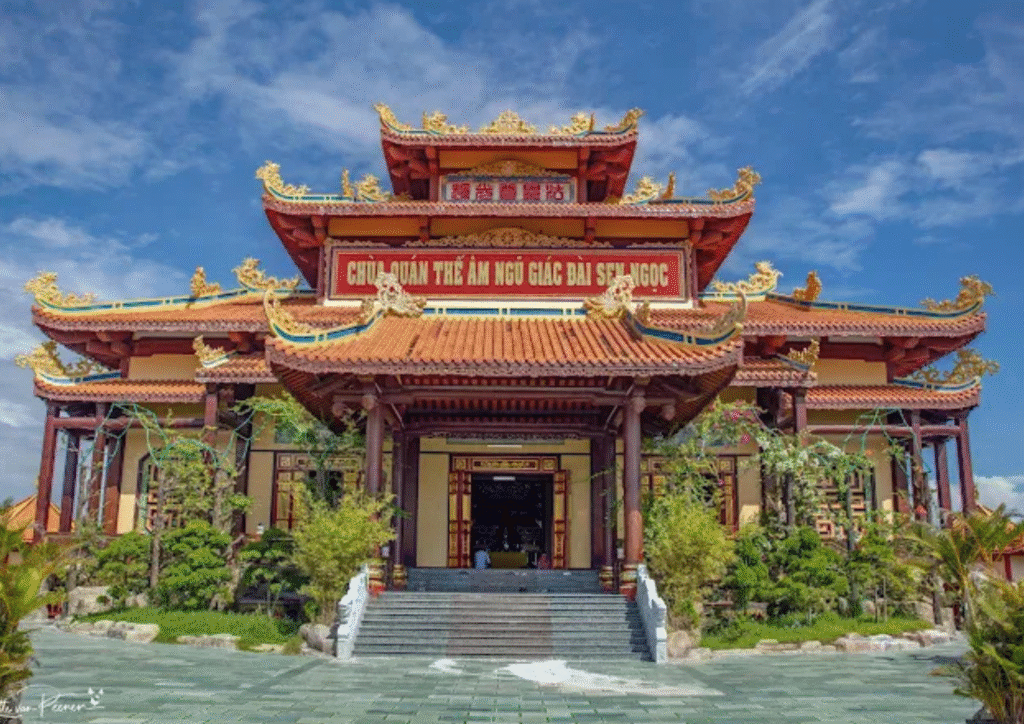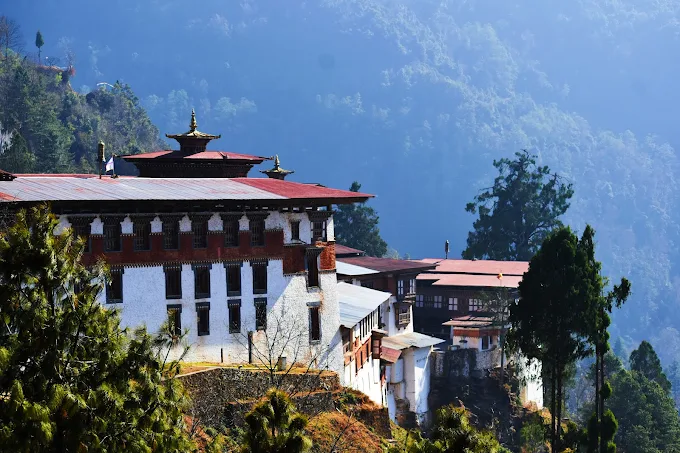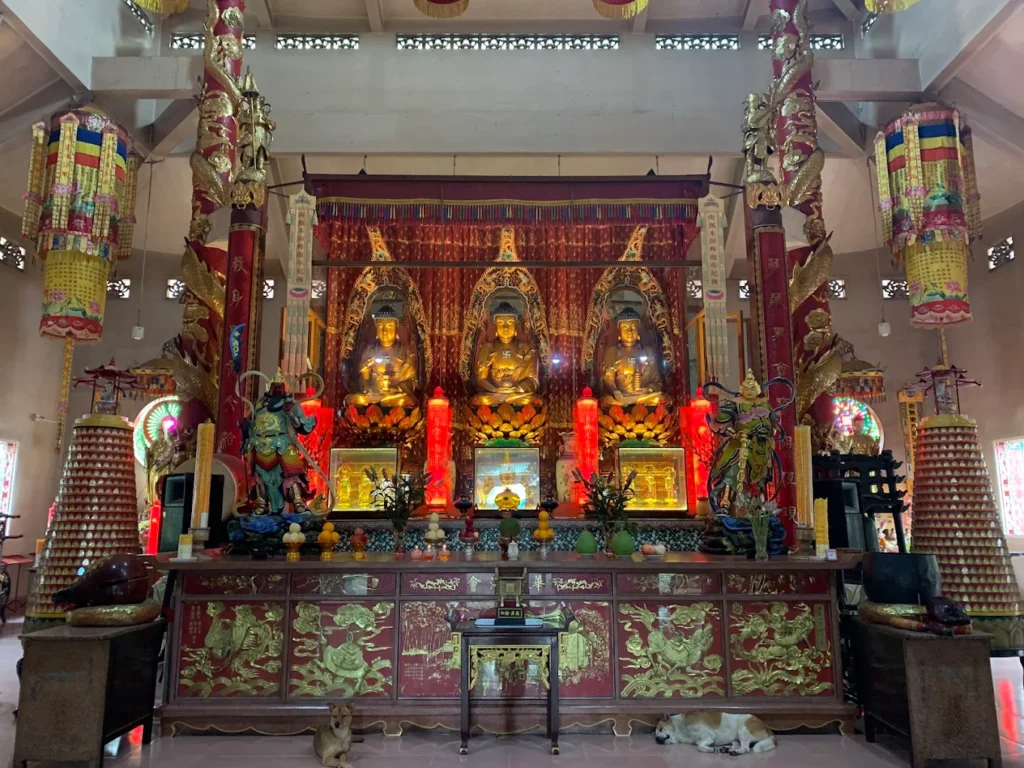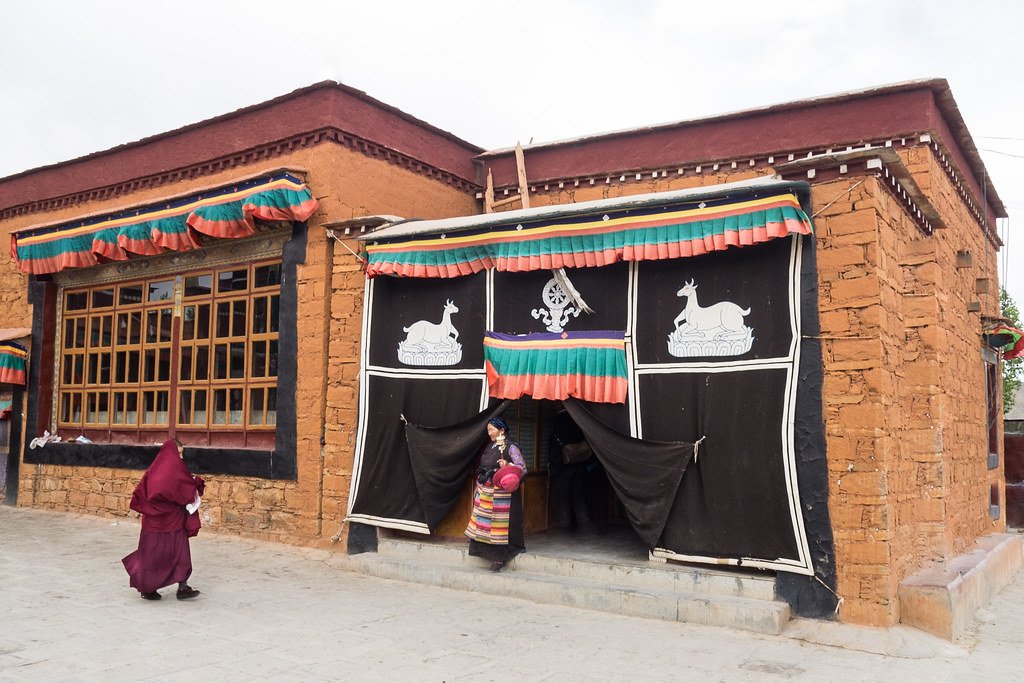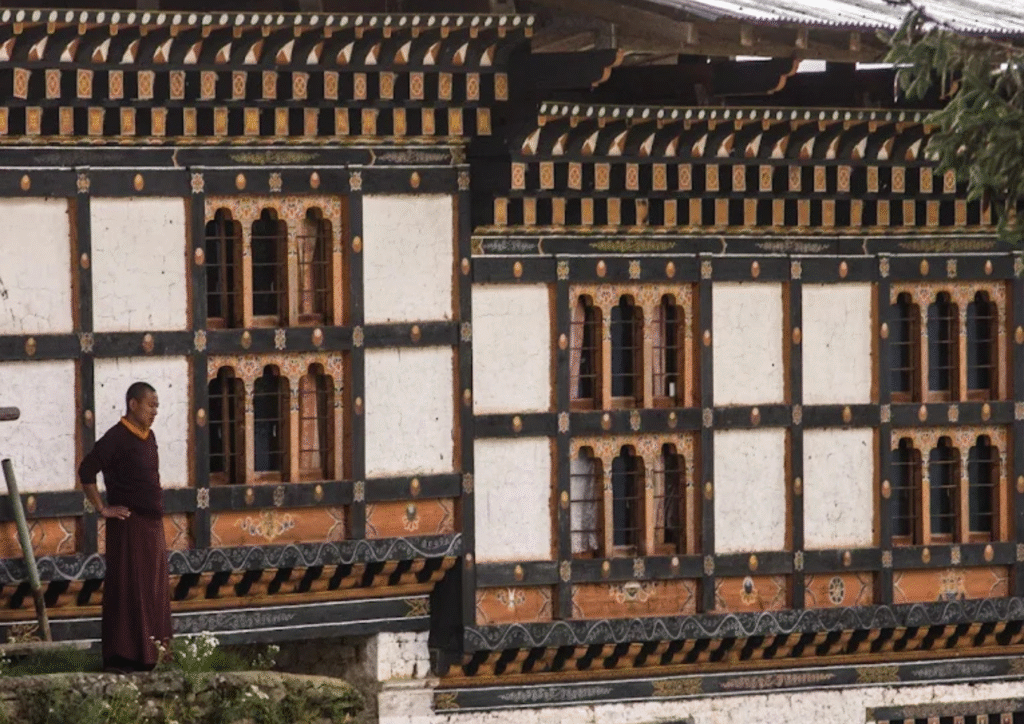Quan Âm Các Pagoda: The Whispering Serenity of Vũng Tàu’s Mountainside Sanctuary
Nestled halfway up Vũng Tàu’s Núi Lớn, where wild jasmine perfumes the breeze, Quan Âm Các Pagoda emerges as a tranquil haven of Mahayana Buddhist devotion. In the main hall (chánh điện), devotees light sandalwood incense before a luminous white statue of Avalokitesvara (Quan Thế Âm), her gentle eyes softening the dawn’s glow. The soft chant of the Heart Sutra weaves through ancient banyan trees, harmonizing with the distant rhythm of waves below. Founded nearly three centuries ago by ethnic Vietnamese (Kinh) Buddhists, its mossy stone steps and weathered walls whisper tales of enduring faith. Each lotus flower or flickering candle offered to Avalokitesvara honors her as the Bodhisattva of Compassion, a guide for seeking souls. From its mountainside perch, the pagoda gazes over Vũng Tàu’s shimmering coastline, a serene sentinel inviting pilgrims to find peace in nature’s embrace. This sacred refuge calls travelers, seekers, and scholars to pause and connect with Vietnam’s spiritual heart.
Echoes of Compassion: Overview and Significance
Introduction to Quan Âm Các Pagoda
Quan Âm Các Pagoda, cradled in hẻm 542 Trần Phú on Vũng Tàu’s Núi Lớn, is a cherished Mahayana Buddhist sanctuary, renowned for its serene mountainside setting and iconic white Avalokitesvara statue. Enveloped by lush forest, it offers a retreat where modern life’s clamor fades into the rustle of leaves and faint sea murmurs. Named for Avalokitesvara, the Bodhisattva of Compassion, the pagoda embodies Mahayana’s call to kindness and mindfulness, drawing pilgrims and visitors seeking solace. Its elevated perch, blending natural splendor with spiritual depth, makes it a cultural and sacred gem in Vietnam’s coastal landscape.
Historical Roots
Quan Âm Các Pagoda traces its beginnings to the early 18th century, when ethnic Vietnamese fishermen, facing the sea’s perils, built a modest shrine to Avalokitesvara for protection. By the mid-18th century, the shrine grew into a small pagoda, with devotees carving stone steps into the mountain to ease pilgrimages. In 1976, a larger main hall formalized its status, and a transformative renovation in 1993 unveiled the striking white Avalokitesvara statue, now a beacon of compassion. Over centuries, the pagoda has endured storms, wars, and time, its resilience mirroring the community’s steadfast faith.
Cultural Resonance
- Mahayana Devotion: Rooted in Mahayana Buddhism, the pagoda centers on Avalokitesvara, guiding devotees toward enlightenment through compassion.
- Ethnic Vietnamese Heritage: A spiritual anchor for the Kinh community, it preserves rituals like sutra chanting and vegetarian feasts, embodying Vietnam’s Buddhist traditions.
- Maritime Connection: Its proximity to Vũng Tàu’s port ties it to fishermen’s prayers for safe voyages, a practice steeped in coastal life.
- Regional Influence: Festivals unite Buddhists from Bà Rịa-Vũng Tàu and Ho Chi Minh City, blending local and regional spiritual expressions.
Unique Legacy
- Avalokitesvara’s Grace: The white statue, poised on a lotus pedestal, radiates compassion, serving as a meditative focal point.
- Mountainside Serenity: The pagoda’s secluded forest setting offers a rare calm, distinct from Vũng Tàu’s vibrant beaches.
- Community Faith: Built and sustained by local devotees, its stone steps and statues reflect grassroots devotion.
- Timeless Appeal: Its fusion of natural beauty and spiritual depth captivates pilgrims, travelers, and cultural explorers.
Community and Global Impact
- Local Devotion: The pagoda hosts Buddhist events, such as vegetarian feasts during festivals, strengthening ethnic Vietnamese Buddhist bonds.
- Pilgrimage Hub: Thousands visit annually, especially during lunar festivals, drawn by its peaceful ambiance and cultural significance.
- Global Reach: International visitors, particularly from Asia, seek its meditative calm, placing it on Vũng Tàu’s spiritual map.
- Cultural Dialogue: Shared rituals bridge local Buddhists and global guests, fostering cross-cultural understanding through prayer.
Modern Relevance
- Spiritual Haven: In a fast-paced world, Quan Âm Các Pagoda offers a sanctuary for mindfulness, appealing to those seeking inner balance.
- Cultural Preservation: It safeguards Mahayana practices, ensuring Vietnam’s Buddhist heritage thrives amid modernity.
- Eco-Spiritual Harmony: Its forest setting promotes environmental awareness, aligning with Buddhist reverence for nature.
Historical Anecdotes
- Fishermen’s Refuge: Early devotees credited Avalokitesvara with guiding boats through typhoons, fueling the pagoda’s growth.
- War-Time Sanctuary: During conflicts, locals found solace in the pagoda’s forest, praying for peace.
- Community Rebuild: The 1993 renovation, driven by local devotion, transformed the pagoda into a regional landmark.
Social Role
- Community Gathering: The pagoda serves as a meeting place for Kinh Buddhists, fostering unity through shared rituals.
- Educational Outreach: Monks teach Buddhist principles to youth, preserving cultural values.
- Charitable Spirit: Festivals include food-sharing events, reflecting Mahayana’s emphasis on generosity.
Crafted by Compassion: Architectural and Spiritual Features
Iconic Design
Quan Âm Các Pagoda’s architecture blends Vietnamese Mahayana simplicity with its rugged surroundings, creating a sanctuary that feels timeless. Stone walls, weathered by coastal winds, and tiled roofs with gentle curves harmonize with Núi Lớn’s slopes. The layout, centered on the main hall, follows Buddhist principles of balance, with open courtyards inviting quiet contemplation. Perched 100 meters above sea level, it frames Vũng Tàu’s coastline, infusing the space with meditative serenity.
Key Structures
- Main Hall (Chánh Điện): The spiritual core, adorned with wooden beams and lotus motifs, houses the Avalokitesvara statue.
- Courtyard: A stone-paved space, shaded by banyans, hosts communal prayers and festivals.
- Meditation Pavilion: An open-air structure overlooking the forest, ideal for silent reflection.
- Stone Steps: Moss-covered steps wind up the mountain, symbolizing the ascent toward enlightenment.
- Bell Tower: A modest stone structure with a bronze bell, rung during ceremonies, resonates through the landscape.
- Garden Shrine: A small outdoor altar for Amitabha Buddha, nestled among jasmine, used for evening prayers.
Worshipped Statues
- Avalokitesvara (Quan Thế Âm): The 5-meter white statue, crafted in 1993, stands on a lotus pedestal, holding a vase of nectar symbolizing compassion. Its flowing robes and serene expression radiate peace.
- Shakyamuni Buddha: A white jade (bạch ngọc) statue depicts the Buddha in meditation, embodying enlightenment.
- Địa Tạng and Quan Công: Bronze statues flank the altar, representing vows to save suffering beings and protect the dharma.
- Spiritual Role: Devotees offer incense and flowers to Avalokitesvara, seeking her compassion, a core Mahayana practice.
Materials and Techniques
- Construction: Local granite and teak, joined with traditional Vietnamese techniques, ensure resilience.
- Artistry: Lotus carvings and ceramic tiles, crafted by ethnic Vietnamese artisans, reflect Buddhist symbolism.
- Cultural Essence: The design embraces Mahayana simplicity, distinct from ornate Chinese styles, tailored to Vietnam’s coastal context.
Signature Elements
- Avalokitesvara Statue: The white statue, visible from the entrance, anchors the pagoda’s spiritual mission.
- Forest Canopy: Banyan and jasmine trees create a natural sanctuary for meditation.
- Seafront Vista: A terrace offers views of Vũng Tàu’s port, tying spirituality to maritime roots.
Lesser-Known Features
- Ancient Inscriptions: Stone tablets near the courtyard bear 18th-century Vietnamese prayers.
- Hidden Alcove: A shrine to Patriarch Trần Nhân Tông hosts Trúc Lâm-inspired rituals.
- Vintage Bell: A 19th-century bronze bell carries a haunting tone through the forest.
Preservation Efforts
- Restoration (2010): Roof repairs preserved ceramic tiles, maintaining rustic charm.
- Challenges: Coastal humidity erodes stonework, requiring regular volunteer upkeep.
- Modern Additions: Solar-powered lanterns, added in 2023, light the steps for evening pilgrims.
Environmental Integration
- Forest Harmony: The design minimizes disruption to the native ecosystem, preserving tranquility.
- Eco-Practices: Monks lead tree-planting initiatives during festivals, reflecting Buddhist ethics.
- Wildlife Haven: The forest shelters birds and small mammals, enhancing meditative ambiance.
Artisan Narratives
- Statue Craftsmanship: Huế artisans sculpted the Avalokitesvara statue, capturing her serene grace.
- Local Builders: Kinh stonemasons, descendants of early devotees, maintain the steps, a generational labor.
- Tile Makers: Đà Nẵng artisans crafted ceramic tiles with lotus patterns, symbolizing Mahayana purity.
Symbolic Details
- Lotus Motifs: Carved throughout, lotuses represent purity rising above suffering.
- White Statue: Avalokitesvara’s white hue symbolizes compassion’s clarity, contrasting the mountain’s ruggedness.
- Banyan Trees: Their sprawling roots evoke interconnectedness, a Mahayana principle.
Rites of the Heart: Rituals and Practices
Daily Sacred Rites
- Morning Chanting: Monks recite the Heart Sutra at dawn, their voices blending with forest sounds.
- Meditation Sessions: Silent meditation, held twice daily, centers on compassion and calm.
- Incense Offerings: Visitors light sandalwood incense before Avalokitesvara, praying for peace.
Unique Practices
- Compassion Vows: Devotees recite Avalokitesvara’s vows, pledging to aid others, a Mahayana ritual.
- Vegetarian Feasts: Monthly lunar gatherings offer communal vegetarian meals, symbolizing non-violence.
- Signature Ritual: Offering lotus flowers to Avalokitesvara’s statue deepens spiritual connection.
Festival Traditions
- Avalokitesvara’s Birthday (19th day, 2nd lunar month): Flower processions and statue bathing draw hundreds.
- Ullambana Festival: Candle-lit offerings and chants honor ancestors, uniting families.
- Buddha’s Birthday: Lanterns and vegetarian feasts celebrate enlightenment, with Avalokitesvara adorned in silk.
- Statue Veneration: Avalokitesvara’s statue, draped in robes during festivals, radiates reverence.
Visitor Engagement
- Accessible Rituals: Visitors can join chants or offer incense, guided by monks.
- Offerings: Flowers and incense, available at the pagoda shop, invite participation.
- Buddhist Etiquette: Bow three times before the statue, signaling respect.
Spiritual Community Roles
- Monastics: A small group of monks leads rituals and teaches Buddhist principles.
- Lay Devotees: Kinh volunteers organize festivals and maintain the pagoda.
- Statue Care: Daily cleaning of Avalokitesvara’s statue reflects devotion.
Interfaith Connections
- Syncretic Practices: Some blend Buddhist prayers with folk beliefs, offering fruit to local deities.
- Outreach: Festivals host interfaith dialogues, welcoming diverse perspectives.
- Education: Monks offer talks on Mahayana principles for non-Buddhist visitors.
Ritual Symbolism
- Lotus Offerings: The lotus mirrors Avalokitesvara’s compassion transcending suffering.
- Incense Smoke: Spiraling upward, it symbolizes prayers reaching the divine.
- Chanting Rhythm: The Heart Sutra aligns breath and mind, guiding mindfulness.
Seasonal Variations
- Spring Festivals: Vibrant with flowers, ideal for Avalokitesvara’s Birthday.
- Autumn Rites: Cooler weather enhances meditative calm during Ullambana.
- Monsoon Season: Chants resonate deeply under rain-soaked banyans, offering unique serenity.
Journey to Tranquility: Visitor Information
Navigating to Quan Âm Các Pagoda
- Location: In hẻm 542 Trần Phú, Phường 5, a 10-minute drive from Vũng Tàu’s center, via a narrow mountain path.
- Landmarks: Near Bến Đình Port, with Vietnamese and English signs guiding the ascent.
- Routes: Taxis or motorbikes from Bãi Sau Beach lead to a short hike up stone steps.
Address of Quan Âm Các Pagoda
- Vietnamese: Chùa Quan Âm Các, Hẻm 542 Trần Phú, Phường 5, Thành phố Vũng Tàu, Tỉnh Bà Rịa-Vũng Tàu.
- English: Quan Âm Các Pagoda, Alley 542 Trần Phú, Ward 5, Vũng Tàu City, Bà Rịa-Vũng Tàu Province.
Visiting Hours and Etiquette
- Hours: Open daily, 6:00 AM–5:00 PM, with extended hours during lunar festivals.
- Etiquette: Remove shoes before the main hall, speak softly, and dress modestly.
- Mahayana Custom: Offer incense with both hands and bow to Avalokitesvara.
Accessibility and Safety
- Mobility: Over 100 stone steps may challenge those with mobility issues; no ramps available.
- Safety: Maintained paths and handrails ensure a secure visit.
- Tips: Wear sturdy shoes and carry water for the climb.
Amenities and Surroundings
- Facilities: Restrooms and a shop offer incense, flowers, and Buddhist texts.
- Nearby: Bến Đình Port and Bãi Sau Beach, within 3 km, offer maritime and leisure experiences.
- Dining: Vegetarian stalls near Trần Phú serve mindful meals.
Immersive Visitor Tips
- Best Timing: Dawn visits offer serene chants and cooler temperatures.
- Sensory Moments: Inhale jasmine air and hear forest birds for deeper calm.
- Statue Connection: Offer lotus flowers to Avalokitesvara and meditate briefly.
- Festival Planning: Attend Avalokitesvara’s Birthday for vibrant processions.
Nearby Cultural Experiences
- Bến Đình Port: Explore Vũng Tàu’s fishing culture, 1 km away.
- Núi Lớn Trails: Hike for coastal panoramas, enhancing the pagoda’s setting.
- Chợ Phường 5: A local market, 2 km away, offers Buddhist offerings.
Transport Options
- By Taxi: A reliable choice from Vũng Tàu’s center, with drop-off near the alley.
- By Motorbike: Offers flexibility to navigate the path and explore nearby.
- On Foot: A 20-minute hike from Bến Đình rewards fit visitors.
Deepening the Experience: Cultural and Spiritual Insights
Mahayana Philosophy
Quan Âm Các Pagoda embodies Mahayana’s core: compassion as the path to enlightenment. Avalokitesvara, hearing the world’s cries, inspires kindness, reflected in vegetarian feasts and outreach. “Emptiness” (Chơn Không) underscores interconnectedness, encouraging release of ego-driven desires.
Maritime Spirituality
The pagoda’s coastal proximity ties it to Vũng Tàu’s fishermen, who sought Avalokitesvara’s protection. Lotus offerings symbolize purity amid life’s storms. The sea-facing terrace invites prayers that drift toward the horizon, connecting visitors to this coastal faith.
Artistic Symbolism
Lotus motifs symbolize purity rising above suffering. The white Avalokitesvara statue, contrasting the mountain’s ruggedness, embodies grace amid adversity. These elements invite contemplation of resilience and compassion.
Community Resilience
The pagoda reflects Kinh perseverance, built by fishermen and merchants without state aid. Volunteer-led festivals and upkeep continue this grassroots spirit, making it a symbol of unity.
Environmental Stewardship
The forest setting fosters Buddhist environmental ethics. Tree-planting initiatives and a wildlife-friendly ecosystem enhance meditation. Visitors are urged to tread lightly, honoring nature.
Meditative Practices
Mahayana meditation focuses on visualizing Avalokitesvara’s compassion. The meditation pavilion, guided by monks, offers a quiet space for inner peace, amplified by the pagoda’s serene setting.
Cultural Narratives
- Fishermen’s Tales: Legends of Avalokitesvara guiding boats through storms fuel devotion.
- Monastic Wisdom: Monks share stories of early pilgrims, linking past and present.
- Festival Lore: Avalokitesvara’s Birthday processions carry centuries-old chants, preserving oral traditions.
Practical Planning for Pilgrims
Optimal Visit Seasons
- Spring (February–April): Mild weather and blooming jasmine enhance the climb, with Avalokatilevara’s Birthday adding vibrancy.
- Autumn (September–November): Cooler temperatures and clear skies offer stunning views.
- Avoid: Summer (June–August) brings rain, making steps slippery.
Packing Essentials
- Clothing: Lightweight, modest attire (long pants, covered shoulders) respects etiquette.
- Footwear: Sturdy sneakers for steps, with socks for barefoot entry.
- Supplies: Water bottle, towel for humidity, notebook for reflections.
- Offerings: Incense or lotus flowers, available at the shop, for rituals.
Photography Tips
- Best Angles: Capture Avalokitesvara’s statue at dawn for soft light.
- Respectful Shots: Avoid photographing monks or devotees during prayers.
- Scenic Views: The terrace offers coastal shots, stunning at sunset.
- Equipment: A smartphone or lightweight camera suffices.
Connecting with the Community
- Monastic Guidance: Approach monks for Mahayana insights; some speak basic English.
- Festival Participation: Join vegetarian feasts to bond with locals.
- Volunteer Opportunities: Inquire about tree-planting or upkeep events.
Mindful Exploration
- Pacing the Climb: Take the steps slowly, reflecting with each step.
- Quiet Observation: Sit in the courtyard to absorb the pagoda’s calm.
- Journaling: Record thoughts in the meditation pavilion for deeper insight.
Reflecting on the Journey
Quan Âm Các Pagoda is a sanctuary where the heart finds refuge amid nature’s embrace. The white Avalokitesvara statue, standing sentinel on Núi Lớn, embodies compassion that transcends borders, inviting all to listen to the world’s quiet wisdom. Its stone steps, worn by centuries of pilgrims, tell a story of resilience, faith, and unity, rooted in Vietnam’s Mahayana soul. Whether meditating before the Bodhisattva, chasing coastal vistas, or tracing cultural threads, visitors find a space to reflect and reconnect. As you descend, the echo of sutras and scent of jasmine linger, a reminder that peace is always within reach.

